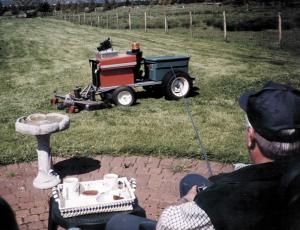2001 - Volume #25, Issue #4, Page #43
[ Sample Stories From This Issue | List of All Stories In This Issue | Print this story
| Read this issue]
Remote-Controlled Mower Saves Inventor's Back
 |
 |
Godfrey is a retired electrical engineer who has about 3/4 of an acre of lawn to mow. He'd been using a 35-year-old Allis Chalmers garden tractor with a 42 in. deck. "I have arthritis and as the years went on, the pain in my back from riding that old tractor got worse and worse," he says.
Once he found the remote control, he started putting together a collection of parts that he could use to build a remote-controlled electric lawn mower.
"I knew that General Electric used to make several models of electric riding mowers back in the 1970s so I went looking for one," he says. He located a GE Elec-Trak that was nearly 30 years old.
"It had sat out back of a barn for years and was really just rusted junk. There was a lot of work to be done on it, but the drive motor and transaxle still worked." He paid $200 for it.
Once he got it home, he tore off the seat and steering wheel, since he didn't plan to ride on the machine. He upgraded the motor controllers to more modern technology and redesigned the entire drive train.
"The 42-in. mower deck has three blades and each is driven by a separate motor. I had to rebuild those motors, but it wasn't that difficult," he notes.
In place of the steering wheel, he added a steering motor. Another motor raises and lowers the deck. With the main drive motor, that makes six different electric motors on the mower.
He installed model airplane remote control servos on the mower to turn the motors on and off. He uses the joystick to control steering and other buttons to run the deck lift and mower motors.
Once he put the mower to work, he found he liked sitting on his porch to mow his grass.
But it didn't take him long to realize that it was difficult to gauge how close the machine was to trees and fences. He decided to mount an old Canon 8 mm video camera on the mower. He wired it to a miniature transmitter that sends the picture to a receiver hooked to Godfrey's television set.
"The video transmitter is the kind of equipment they use in security systems," he explains. "It's not extremely powerful, but it sends the picture signal about 1,000 ft., which is more than enough for this use."
The camera makes it easier but he still has to pay attention. "It takes a lot of concentration to drive it. The steering is rather precise and my backyard is not smooth, so I watch the screen all the time.
There's a golf course behind his house and golfers often stare as the riderless machine trundles across the turf. "I do get some interesting comments," he says.
Godfrey says it took most of a year to get the mower together and operating, and he figures it cost between $1,000 and $1,500 in total. "The most expensive part was the batteries. I obtained three new large, high tech batteries (Optima Group 32 spiral wound prototypes) for $200 apiece," he says. These batteries operate the mower for more than two hours before reaching 50 percent discharge. Recharging them with the onboard charger takes four to five hours.
Still, he doesn't consider it a high-tech machine. "I used a lot of old junk-box parts rather than a new computerized or solid state circuits," he says.
He's shown it off a few times at shows and fairs and participated with it in an electric tractor pull. He won.
Contact: FARM SHOW Followup, Al Godfrey, 17351 Fedoruk Road, Richmond, British Columbia, Canada V6V 1C6 (ph 604 278-5795; E-mail: algodfrey@home.com).

Click here to download page story appeared in.

Click here to read entire issue
To read the rest of this story, download this issue below or click here to register with your account number.




